Abstract
(-)-Isoprenaline and the selective beta 1-adrenoceptor agonist RO363 were tested for their inotropic effects in left atrial (beta 1) and relaxant effects in K+-depolarized uterine (beta 2) preparations from the guinea-pig. The drugs had similar activities as positive inotropic agents but RO363 was approximately 400 times less active than (-)-isoprenaline as a uterine relaxant. RO363 had intrinsic activities of 0.8 and 0.25 ((-)-isoprenaline = 1) in atrial and uterine preparations, respectively. Apparent dissociation constants (KD values) determined from the ability of the agonists to displace (-)-[125I]-iodocyanopindolol ([125I]-CYP) bound to membranes prepared from both tissues were used as a measure of affinity. The [125I]-CYP binding sites possessed the characteristics of homogeneous populations of beta 1-adrenoceptors in atrial and beta 2-adrenoceptors in uterine membrane preparations. The pKD values for (-)-isoprenaline were similar in the two tissues (left atria 6.4, uterus 6.0) whilst for RO363 the atrial value (7.8) was considerably greater than that for the uterus (6.0). The latter value is very similar to the pKB value determined from shifts in (-)-isoprenaline curves produced by RO363 in uterine preparations. Graphical plots of the fraction of receptors occupied vs response were constructed. The relative efficacy of (-)-isoprenaline with respect to RO363 was calculated to be 25 in atrial and 2633 in uterine preparations. The selective beta 1-adrenoceptor stimulant actions of RO363 are a reflection of both its greater affinity and efficacy for beta 1- as opposed to beta 2-adrenoceptor sites.(ABSTRACT TRUNCATED AT 250 WORDS)
Full text
PDF
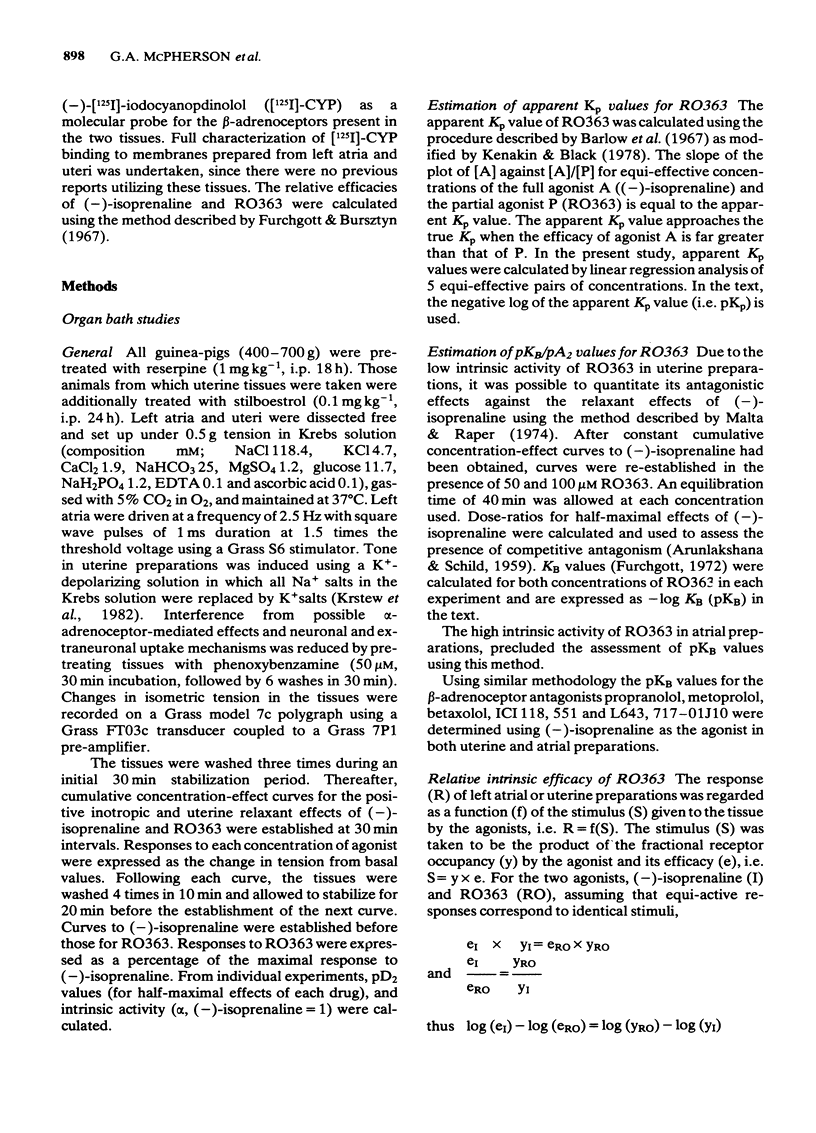
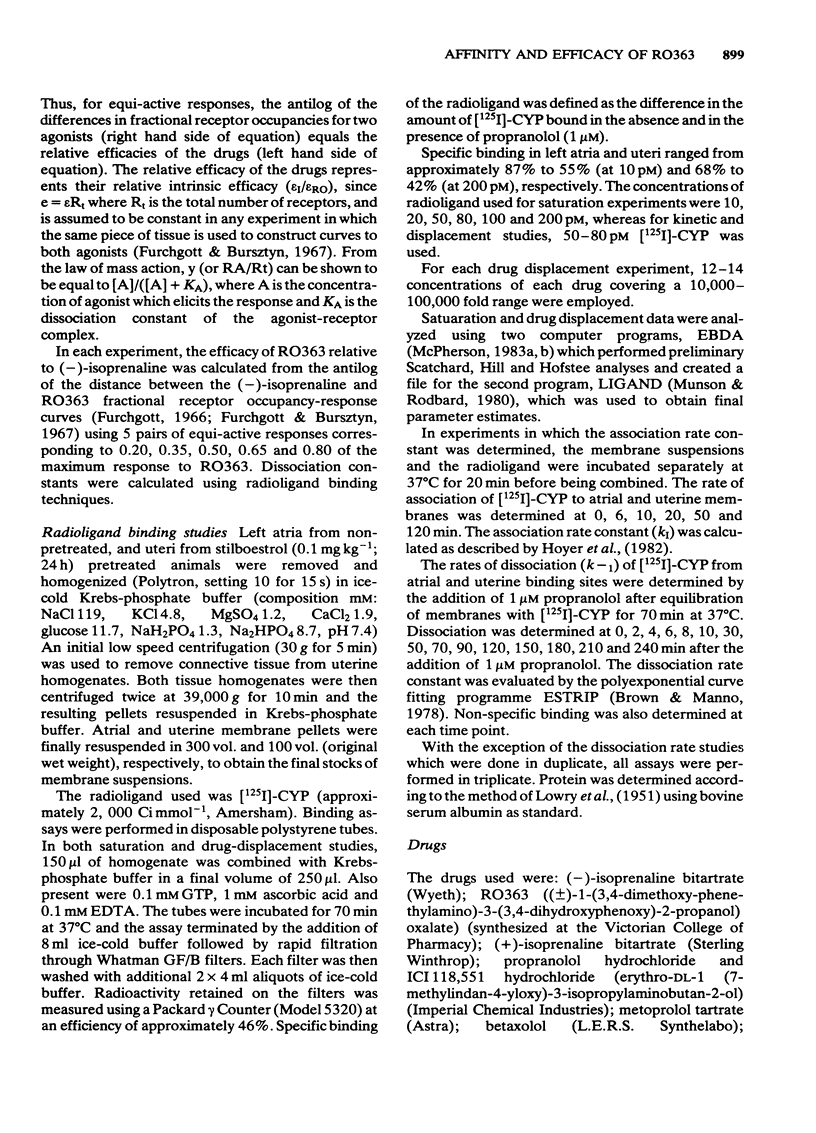
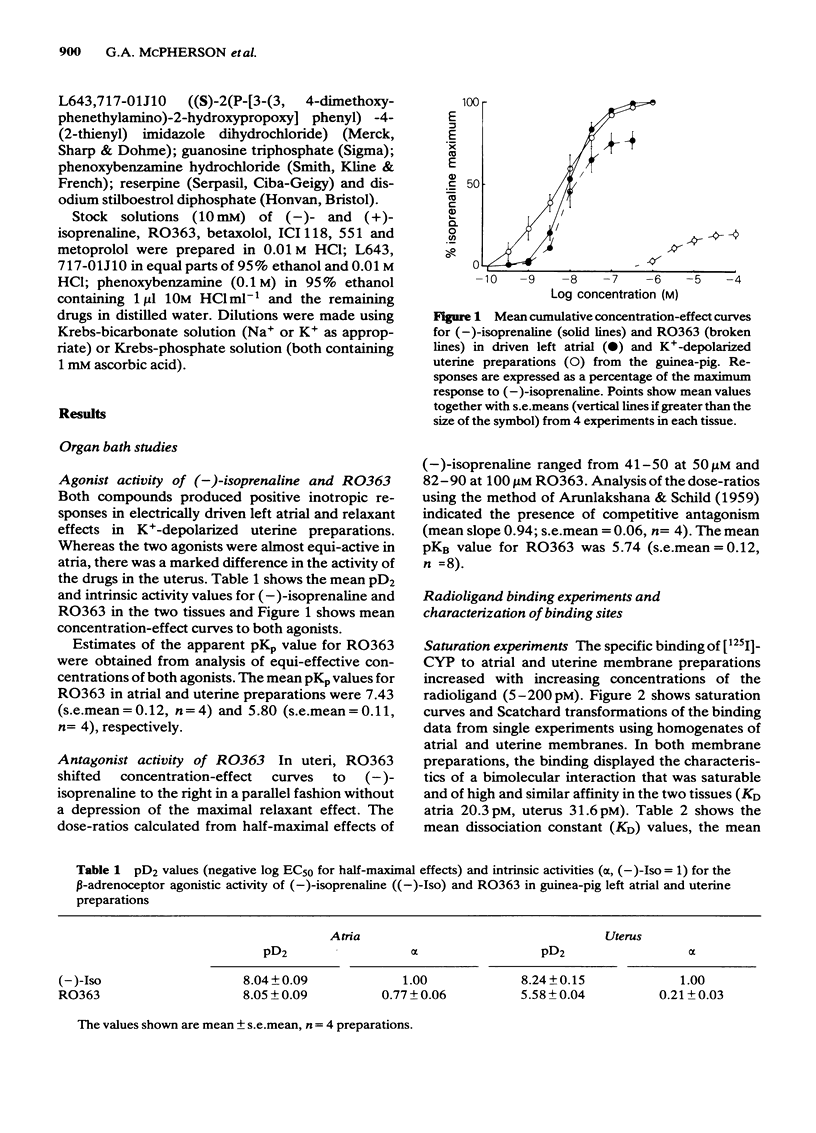


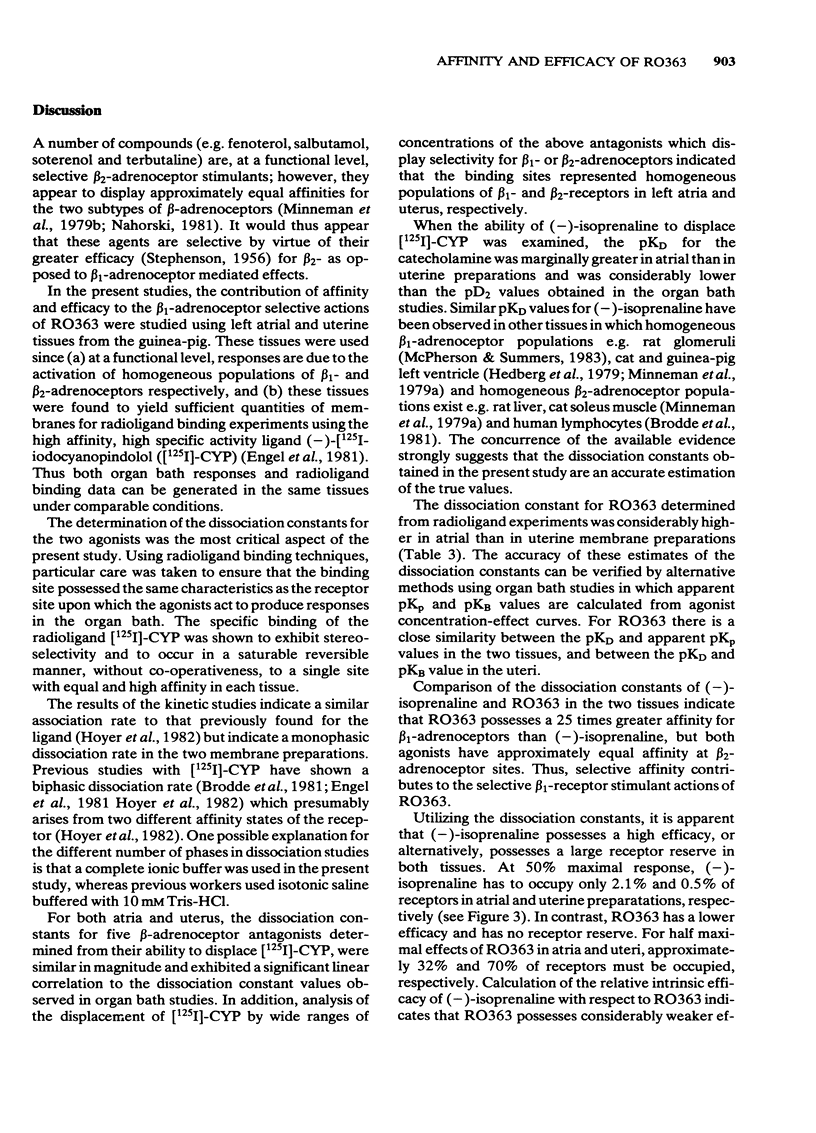
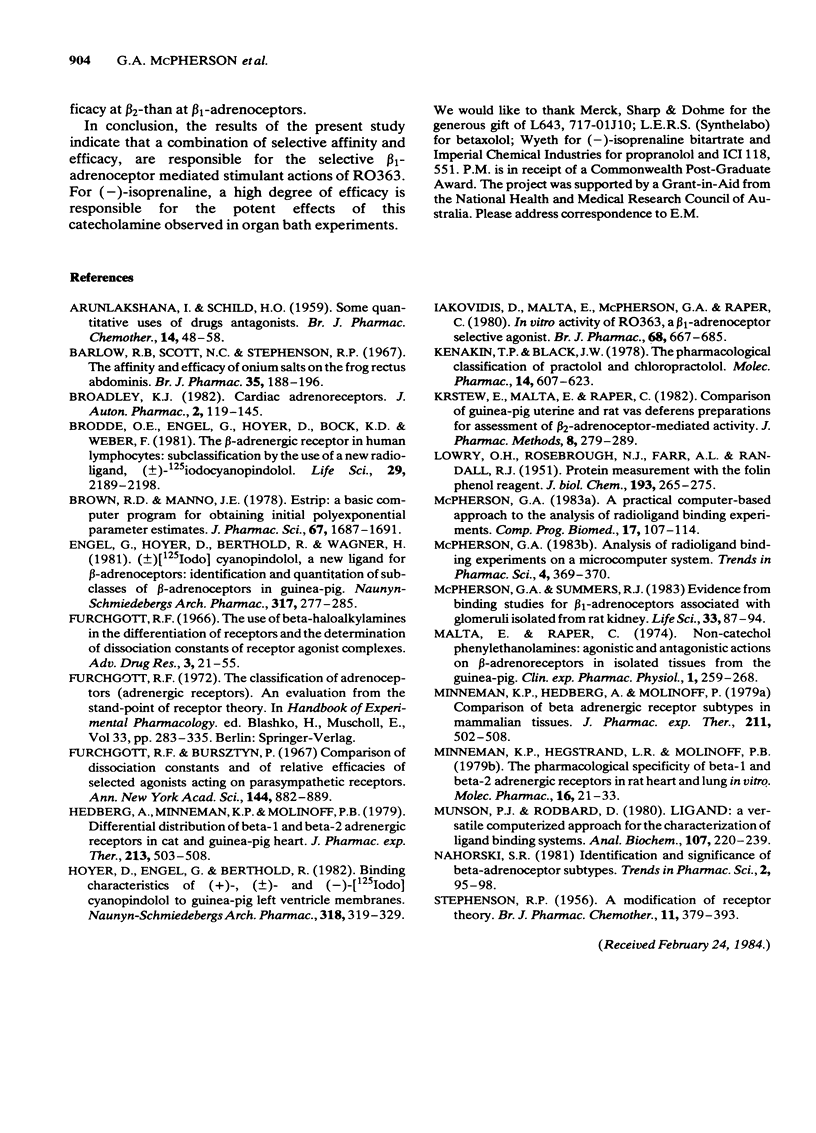
Selected References
These references are in PubMed. This may not be the complete list of references from this article.
- ARUNLAKSHANA O., SCHILD H. O. Some quantitative uses of drug antagonists. Br J Pharmacol Chemother. 1959 Mar;14(1):48–58. doi: 10.1111/j.1476-5381.1959.tb00928.x. [DOI] [PMC free article] [PubMed] [Google Scholar]
- Barlow R. B., Scott N. C., Stephenson R. P. The affinity and efficacy of onium salts on the frog rectus abdominis. Br J Pharmacol Chemother. 1967 Sep;31(1):188–196. doi: 10.1111/j.1476-5381.1967.tb01989.x. [DOI] [PMC free article] [PubMed] [Google Scholar]
- Brodde O. E., Engel G., Hoyer D., Bock K. D., Weber F. The beta-adrenergic receptor in human lymphocytes: subclassification by the use of a new radio-ligand, (+/-)-125 Iodocyanopindolol. Life Sci. 1981 Nov 23;29(21):2189–2198. doi: 10.1016/0024-3205(81)90490-2. [DOI] [PubMed] [Google Scholar]
- Brown R. D., Manno J. E. ESTRIP, a BASIC computer program for obtaining initial polyexponential parameter estimates. J Pharm Sci. 1978 Dec;67(12):1687–1691. doi: 10.1002/jps.2600671214. [DOI] [PubMed] [Google Scholar]
- Engel G., Hoyer D., Berthold R., Wagner H. (+/-)[125Iodo] cyanopindolol, a new ligand for beta-adrenoceptors: identification and quantitation of subclasses of beta-adrenoceptors in guinea pig. Naunyn Schmiedebergs Arch Pharmacol. 1981;317(4):277–285. doi: 10.1007/BF00501307. [DOI] [PubMed] [Google Scholar]
- Hoyer D., Engel G., Berthold R. Binding characteristics of (+)-, (+/-)- and (-)-[125iodo] cyanopindolol to guinea-pig left ventricle membranes. Naunyn Schmiedebergs Arch Pharmacol. 1982 Mar;318(4):319–329. doi: 10.1007/BF00501172. [DOI] [PubMed] [Google Scholar]
- Iakovidis D., Malta E., McPherson G. A., Raper C. In vitro activity of RO363, a beta1-adrenoceptor selective agonist. Br J Pharmacol. 1980 Apr;68(4):677–685. doi: 10.1111/j.1476-5381.1980.tb10860.x. [DOI] [PMC free article] [PubMed] [Google Scholar]
- Kenakin T. P., Black J. W. The pharmacological classification of practolol and chloropractolol. Mol Pharmacol. 1978 Jul;14(4):607–623. [PubMed] [Google Scholar]
- Krstew E., Malta E., Raper C. Comparison of guinea pig uterine and rat vas deferens preparations for assessment of beta 2-adrenoceptor-mediated activity. J Pharmacol Methods. 1982 Dec;8(4):279–289. doi: 10.1016/0160-5402(82)90045-6. [DOI] [PubMed] [Google Scholar]
- LOWRY O. H., ROSEBROUGH N. J., FARR A. L., RANDALL R. J. Protein measurement with the Folin phenol reagent. J Biol Chem. 1951 Nov;193(1):265–275. [PubMed] [Google Scholar]
- Malta E., Raper C. Non-catechol phenylethanolamines: agonistic and antagonistic actions on beta-adrenoreceptors in isolated tissues from the guinea-pig. Clin Exp Pharmacol Physiol. 1974 May-Jun;1(3):259–268. doi: 10.1111/j.1440-1681.1974.tb00548.x. [DOI] [PubMed] [Google Scholar]
- McPherson G. A. A practical computer-based approach to the analysis of radioligand binding experiments. Comput Programs Biomed. 1983 Aug-Oct;17(1-2):107–113. doi: 10.1016/0010-468x(83)90031-4. [DOI] [PubMed] [Google Scholar]
- McPherson G. A., Summers R. J. Evidence from binding studies for beta 1-adrenoceptors associated with glomeruli isolated from rat kidney. Life Sci. 1983 Jul 4;33(1):87–94. doi: 10.1016/0024-3205(83)90715-4. [DOI] [PubMed] [Google Scholar]
- Minneman K. P., Hedberg A., Molinoff P. B. Comparison of beta adrenergic receptor subtypes in mammalian tissues. J Pharmacol Exp Ther. 1979 Dec;211(3):502–508. [PubMed] [Google Scholar]
- Minneman K. P., Hegstrand L. R., Molinoff P. B. The pharmacological specificity of beta-1 and beta-2 adrenergic receptors in rat heart and lung in vitro. Mol Pharmacol. 1979 Jul;16(1):21–33. [PubMed] [Google Scholar]
- Munson P. J., Rodbard D. Ligand: a versatile computerized approach for characterization of ligand-binding systems. Anal Biochem. 1980 Sep 1;107(1):220–239. doi: 10.1016/0003-2697(80)90515-1. [DOI] [PubMed] [Google Scholar]
- STEPHENSON R. P. A modification of receptor theory. Br J Pharmacol Chemother. 1956 Dec;11(4):379–393. doi: 10.1111/j.1476-5381.1956.tb00006.x. [DOI] [PMC free article] [PubMed] [Google Scholar]


